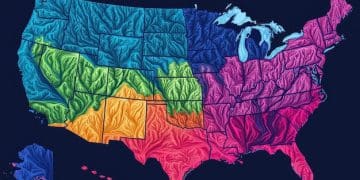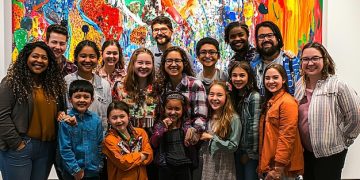Decoding American Humor: A Guide to US Jokes & Sarcasm

Anúncios
Decoding American Humor: A Guide to Understanding Jokes and Sarcasm in US Culture explores the styles, cultural nuances, and historical influences that shape American comedic sensibilities, helping non-natives navigate its unique and often subtle forms.
American humor can be a tricky landscape to navigate. This guide, Decoding American Humor: A Guide to Understanding Jokes and Sarcasm in US Culture, will help you understand the subtle nuances and cultural references that make Americans laugh.
Anúncios
Why is American Humor So Unique?
American humor is a melting pot, influenced by a variety of cultures, historical events, and social trends. To truly understand it, one must delve into its complexities.
Understanding American humor is more than just getting the joke; it’s about appreciating the values, anxieties, and perspectives of a nation.
Anúncios
Historical Influences on American Comedy
The roots of American humor can be traced back to various sources, from early vaudeville acts to the satirical writings of Mark Twain.
These historical influences have shaped the comedic landscape, creating a unique blend of wit, satire, and observational humor.
- Vaudeville: Provided a platform for diverse comedic styles, including slapstick and wordplay.
- Mark Twain: Master of satire, skewering social norms and political corruption with humor.
- Radio comedy: Introduced iconic comedic characters and catchphrases that permeated American culture.
The historical context provides a rich tapestry that informs and shapes current comedic styles.

Common Types of American Humor
American humor comes in many forms, each with its own set of characteristics and appeal. Understanding these different types can help you appreciate the breadth of American comedy.
From observational humor to self-deprecating jokes, the variety within American comedy reflects the varied experiences and perspectives of its people.
Observational Humor
Observational humor focuses on everyday life and the absurdities within it. Comedians like Jerry Seinfeld have mastered this art.
It’s relatable, often poking fun at common human experiences and social interactions.
Self-Deprecating Humor
This type of humor involves making fun of oneself, often highlighting personal flaws or shortcomings. It can be a way to connect with others through shared experiences.
It can also be used to disarm potential critics or deflect attention from sensitive topics.
- Relatability: Audiences connect with comedians who are willing to laugh at themselves.
- Humility: Self-deprecation can convey a sense of humility and approachability.
- Deflection: It can be used to diffuse tension or address uncomfortable truths in a lighthearted way.
This variety allows for deep connection and resonance with the audience.
The Role of Sarcasm in American Communication
Sarcasm is a prevalent form of humor and communication in American culture. It involves saying the opposite of what you mean, often with a tone of irony or mockery.
Mastering sarcasm requires understanding both verbal cues and contextual clues.
Detecting Sarcasm
Understanding the use of sarcasm in the American culture is very important to properly communicate in the US.
Detecting sarcasm can be challenging, especially for those unfamiliar with the cultural nuances.
Pay attention to tone of voice, facial expressions, and the context of the conversation.
Why Americans Use Sarcasm
Sarcasm can be used for various reasons, from expressing disapproval to creating a lighthearted atmosphere. Sometimes, it is a way to indirectly express feelings.
Its prevalence reflects a cultural preference for indirect communication and a tolerance for ambiguity.
It is especially important to master sarcasm when conversing professionally.
Ultimately, understanding sarcasm is key to unlocking a deeper understanding of American culture and communication styles.
Cultural References in American Jokes
American jokes often rely on cultural references, which can be obscure to outsiders. These references may include historical events, pop culture phenomena, or political figures.
To truly understand these jokes, one must have some familiarity with American culture and history.
Pop Culture
References to movies, TV shows, music, and celebrities are common in American humor. These references can range from classic films to current viral trends.
Staying up-to-date with pop culture can help you understand these jokes and participate in the humor.
Politics and Current Events
Political satire is a staple of American comedy. Comedians often use humor to critique politicians, policies, and social issues.
- Political Cartoons: Visual commentary that uses humor to convey political messages.
- Late-Night Talk Shows: Monologues and sketches that satirize current events and political figures.
- Social Media: Memes and viral content that use humor to express political opinions.
By exploring these jokes, one can understand complex current events.

How American Humor Differs Regionally
American humor is not monolithic; it varies regionally. Different parts of the country have their own comedic traditions and styles.
Understanding these regional differences can help you better appreciate the diversity of American humor.
Southern Humor
Southern humor often relies on storytelling, character-driven narratives, and a gentle, self-deprecating wit. It may involve tall tales and exaggerated anecdotes.
Common themes include family, religion, and rural life.
Northeast Humor
Northeast humor tends to be more fast-paced, sarcastic, and self-aware. It may reflect the urban environments and intellectualism of the region.
Characteristics often include irony, satire, and observational humor.
It is important to respect boundaries, as many jokes are seen as inappropiate.
Recognizing these styles makes communication easier.
Tips for Navigating American Humor
Navigating American humor can be challenging, but it is an important part of understanding American culture. Here are some tips to help you get the hang of it.
With practice and patience, you can learn to appreciate and even participate in American humor.
Be Observant
Pay attention to the context, tone of voice, and facial expressions of the speaker. These cues can help you understand the intent behind the humor.
In some instances, the speaker may not be trying to joke.
Ask for Clarification
If you don’t understand a joke, don’t be afraid to ask for clarification. Most Americans will be happy to explain it to you, and it shows that you’re engaged and interested.
- Acknowledge Uncertainty: Start by saying, “I’m not sure I understand…”
- Be Polite: Use a respectful and curious tone.
- Avoid Assumptions: Don’t assume you know the answer; genuinely seek clarity.
By following these tips, you can improve your success in participating.
| Key Element | Brief Description |
|---|---|
| 😂 Sarcasm | Saying the opposite of what you mean for humorous effect. |
| 🎬 Pop Culture | Referencing movies, music, and celebrities for humor. |
| 🗣️ Observational | Humor based on everyday life observations. |
| 🤣 Self-deprecating | Making fun of oneself to create humor. |
FAQ
▼
Sarcasm in the United States serves multiple functions, including humor, criticism, and indirect communication. It can also foster camaraderie by creating an “in-group” feeling among those who understand the joke.
▼
Pay attention to tone, context, and non-verbal cues. Watch American TV shows and movies to observe how sarcasm is used in different situations. If unsure, ask for clarification.
▼
Observational humor is a style of comedy that focuses on everyday life and the absurdities of human behavior. Comedians point out the ironies and quirks in ordinary situations, making it relatable.
▼
Yes, humor varies regionally. Southern humor often involves storytelling and gentle wit, while Northeast humor tends to be more sarcastic and fast-paced. Western humor may reflect a more laid-back attitude.
▼
Yes, it’s perfectly acceptable to ask for clarification if you don’t understand a joke. Most people will appreciate your curiosity and be happy to help you understand the humor.
Conclusion
By understanding the nuances of American humor, you can better connect with people in the United States and appreciate the unique cultural landscape. From sarcasm to observational humor, the world of American comedy is diverse and rewarding to explore.





